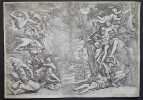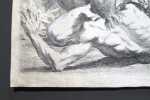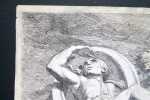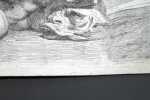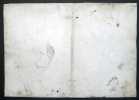TESTA (Pietro)
(Allégorie de l'Hiver) (Allegory of winter) (allegoria dell'inverno). Estampe originale à l'eau-forte.
Roma, Rossi, 1647. (72 x 50,2 cm au coup de planche, marges : 1cm environ.
Reference : 31767
Planche "Hiver" seule, de la série des Quatre saisons. Mention en bas à droite, sur le cuivre : "Si Stampano in Roma alla pace per Giouan Jacomo Rossi all insegna di Parigi" - "Petrus Testa Pinxit et Sculpsit 1647". Pietro Testa était considéré par ses contemporains comme le meilleur graveur italien du XVII° siècle. Il rejoignit l'atelier de Domenichino en 1628, où il côtoya entre autre Nicolas Poussin. "Le Lucchesino", ainsi surnommé en référence à Lucca, sa ville natale, grava ses premières planches vers 1631-1632. Il délaissa alors la peinture pour se consacrer à la gravure, son domaine d'excellence. - Le rédacteur de la notice du Fine Arts Museums of San-Francisco n'hésite pas envers cette "Allégorie de l'hiver" : "Apotheosis of the Artist’s Genius". A superb draftsman and printmaker, Pietro Testa was described by contemporaries as the best Italian etcher of the 17th century. Less successful as a painter, Testa also left preparatory notes for a treatise on the principles of art, describing ideas about theory and practice that he also expressed in his etchings. He ended his life by suicide when he was thirty-seven. Born in Lucca and baptized on June 18, 1612, Testa’s father was a dealer in secondhand merchandise. Nothing is known about any artistic training Testa may have had in Lucca. Testa went to Rome around 1628. He entered the studio of Domenichino (1581-1641), received instruction in drawing, and went about Rome drawing antiquities. Through this school Testa met Nicolas Poussin (1594-1665) and others in his circle. Joachim von Sandrart (1606-1688), the German artist and writer then in Rome, wrote that he discovered Testa making drawings out among ancient ruins. Sandrart gave him clothing and money and recruited Testa to make drawings of the collection of ancient statutes in the collection of Marchese Vincenzo Giustiniani (1564–1637), later engraved and published as the Galleria Giustiniani. Testa also worked on the “Museo cartaceo” (“Paper Museum”) of Cassiano dal Pozzo (1588-1657), an ambitious undertaking to create drawings of all the ruins and antiquities of Rome. A contemporary biographer wrote that Testa created five volumes of such drawings. Around this time Testa received the nickname “il Lucchesino,” after his birthplace. Domenichino had closed his school and gone to Naples by June 1631, and Testa joined the studio of Pietro da Cortona (1596-1669). This relationship was short-lived; Testa’s nature, described by all early biographers as bitter and difficult, led to disagreements with da Cortona, who expelled Testa from the studio. His earliest prints date from this time. Testa had returned to Lucca by August 1632, where he received a commission to paint a fresco in the Palazzo degli Anziani. He had no training in fresco, and his work was not well received. While in Lucca he did meet a prominent cleric and art collector, Girolamo Buonvisi (1607-1677), who became an important patron; Testa dedicated several of prints to Buonvisi. He returned to Rome, probably later in 1632. Several of his paintings have been dated to the 1630s. In 1637 his patron Cassiano dal Pozzo had Testa imprisoned, suspecting that Testa was about to leave Rome without completing two promised paintings. After resolution of these legal difficulties, Testa did go to Lucca to seek the patronage of Cardinal Marcantonio Franciotti (1592-1666), the new bishop of Lucca. A note on a 1637 portrait of Testa drawn by Pier Francesco Mola (1612-1666) recites that it was made in Lucca. Testa celebrated Franciotti’s appointment with two etchings: An Allegory in Honor of the Arrival of Cardinal Franciottias Bishop of Lucca (1637, B. 30) and An Allegory of Painting (1637-38, B. 29), which he dedicated to the Cardinal. Testa returned to Rome after a brief time in Lucca. He continued to receive commissions for paintings through the 1640s and created etchings on allegorical, religious and mythological themes. He probably received more income from his etchings than his painting commissions. He continued to receive support and commissions from dal Pozzo and Buonvisi, but after the election of Pope Innocent X (1574-1655) in 1644 both patrons fell out of favor and left the papal court, with Buonvisi returning to Lucca. The last years of Testa’s life were increasingly unhappy. Frescoes he painted in a Roman church in 1642 were destroyed later in the decade, replaced by the work of another artist. A major commission to decorate the apse of another church was withdrawn late in the decade. His last prints were on moralistic themes. Contemporary biographers describe him as deeply melancholy and alienated from the public. Testa drowned in the Tiber on March 1, 1650. (TNB 4/2013) Selected bibliography: Bellini, Paolo and Richard W. Wallace. “Pietro Testa,” in The Illustrated Bartsch, Vol. 45 Commentary, pp. 133-136. New York: Abaris Books, 1990. Cropper, Elizabeth. Pietro Testa, 1612-1650, prints and drawings. Philadelphia: Philadelphia Museum of Art, 1988. [FAM: AFGA NC 257 T4 C7 and ND 623 T39 C7 1988.] Cropper, Elizabeth: The Ideal of Painting: Pietro Testa's Düsseldorf Notebook, Princeton University Press, Princeton, 1984. - Épreuve fortement et habilement restaurée. Trace de pli vertical au centre de la planche, menu frottement avec perte de quelques traits au centre, macules atténuées dans les angles.
Bookseller's contact details
Librairie Devaux
M. Jean-Luc Devaux
26 rue François Péron
03000 Moulins
France
33 04 70 44 02 65
Payment mode




Sale conditions
Conformes aux usages de la Librairie Ancienne et Moderne. Les prix sont nets. Frais de port en sus, emballage gratuit. Les livres voyagent aux risques et périls du destinataire. Expédition à réception du règlement. En cas de paiement par carte bancaire, veuillez ne pas déposer vos n°s de carte sur le site : pour plus de sécurité nous vous envoyons un lien via Banque Populaire SystemPay secure.
 Write to the booksellers
Write to the booksellers